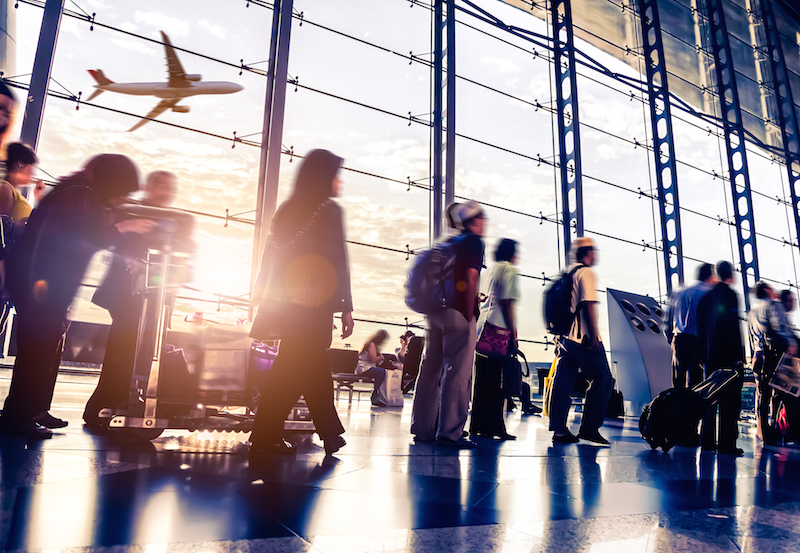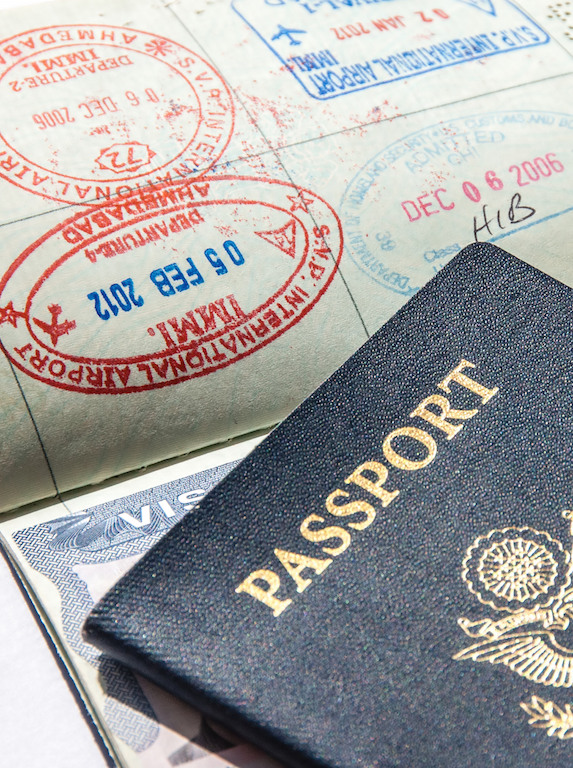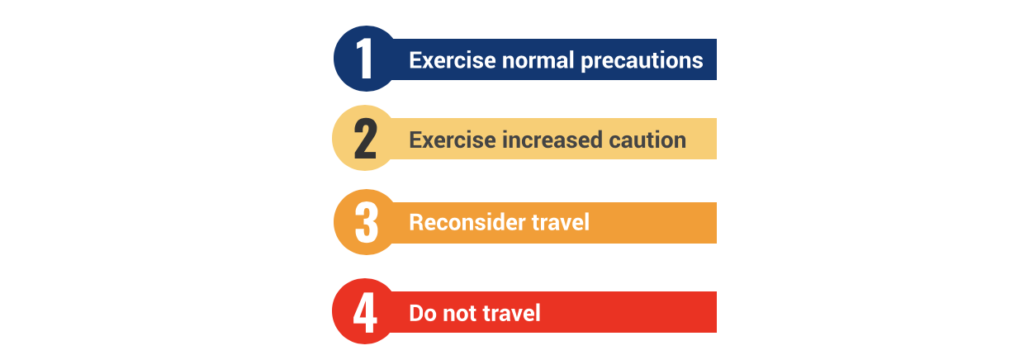It is easier now than ever to travel around the world! Thanks to lower airfares and an abundance of airlines to carry us wherever we want to go, there has never been a better time to see the world. But, before you go, find out what a US travel advisory means and how it may impact your travel!
But, if you are traveling with a US passport, it is currently at the lowest level of “power” that it has been (countries that will accept US passports without requiring visas for travel). Also, if you are traveling with a US passport, there may be some places that you may want to be more concerned of than others. This is where the US travel advisory levels come in – but what do they mean?
What Does a US Travel Advisory Mean?
Link: Interactive Map from the State Department for US Travel Advisories
Put simply, before we dive into the 4 levels, US travel advisory levels are a way for the US State Department to issue warnings/concerns to travelers for visits to various countries. Every so often or when dangerous events occur, they will upgrade/downgrade these advisory levels to give travelers a better idea of any safety concerns that may be in place.
Keep this in mind – there are some people that may travel to a country with a Level 3 or 4 but that does not mean that you need to do that! Also, some countries may have a particular level assignment but that does not mean you need to be scared off just because of that. Like with many things, do your research and decide what you feel comfortable with. I am not going to tell you what to do! 🙂

Courtesy Shutterstock
Below are the descriptions that the US State Department gives for each travel advisory level. I will also include a sample of well-known countries that are currently on each travel advisory level (as of October 10, 2019).
US Travel Advisory Level 1
Exercise Normal Precautions: This is the lowest advisory level for safety and security risk. There is some risk in any international travel. Conditions in other countries may differ from those in the United States and may change at any time.
Some Countries on the US Travel Advisory Level 1 List
- Austria
- Australia
- Aruba
- Belarus
- Cambodia
- Costa Rica
US Travel Advisory Level 2
Exercise Increased Caution: Be aware of heightened risks to safety and security. The Department of State provides additional advice for travelers in these areas in the Travel Advisory. Conditions in any country may change at any time.
Some Countries on the US Travel Advisory Level 2 List
- Cuba
- South Africa
- Sierra Leone
- Jordan
- Belgium
- Italy
US Travel Advisory Level 3
Reconsider Travel: Avoid travel due to serious risks to safety and security. The Department of State provides additional advice for travelers in these areas in the Travel Advisory. Conditions in any country may change at any time.
Some Countries on the US Travel Advisory Level 3 List
- Nicaragua
- Haiti
- Honduras
- Sudan
- Lebanon
US Travel Advisory Level 4
Do Not Travel: This is the highest advisory level due to greater likelihood of life-threatening risks. During an emergency, the U.S. government may have very limited ability to provide assistance. The Department of State advises that U.S. citizens not travel to the country or to leave as soon as it is safe to do so. The Department of State provides additional advice for travelers in these areas in the Travel Advisory. Conditions in any country may change at any time.
Some Countries on the US Travel Advisory Level 3 List
- Iraq
- Iran
- North Korea
- Syria
- Afghanistan
Note – Most of the countries on the Level 4 list were updated on the same day, April 9, 2019.
What Do These Lists Mean in Actual Travel?
You may have noticed that there were a couple of European countries (and actually more) on the Level 2 list. This means to “exercise caution.” Why were these countries given this destination and does it mean that you have cause for concern if you plan to visit these countries?
Fortunately, the US State Department gives us even more information for each country. To research a particular country for the safety level, click this link to go to the US State Department country page.
Once you select your country, you will want to look at the header for that country for the code that says why it was assigned that level. Here are the different codes that they use (the following from this State Department webpage):
Risk Indicators
Travel Advisories at Levels 2-4 contain clear reasons for the level assigned, using established risk indicators and specific advice to U.S. citizens who choose to travel there. These are:
- C – Crime: Widespread violent or organized crime is present in areas of the country. Local law enforcement may have limited ability to respond to serious crimes.
- T – Terrorism: Terrorist attacks have occurred and/or specific threats against civilians, groups, or other targets may exist.
- U – Civil Unrest: Political, economic, religious, and/or ethnic instability exists and may cause violence, major disruptions, and/or safety risks.
- H – Health: Health risks, including current disease outbreaks or a crisis that disrupts a country’s medical infrastructure, are present. The issuance of a Centers for Disease Control Travel Notice may also be a factor.
- N – Natural Disaster: A natural disaster, or its aftermath, poses danger.
- E – Time-limited Event: Short-term event, such as elections, sporting events, or other incidents that may pose safety risks.
- O – Other: There are potential risks not covered by previous risk indicators. Read the country’s Travel Advisory for details.
- K – Kidnapping or Hostage Taking: Criminal or terrorist individuals or groups have threatened to and/or have seized or detained and threatened to kill, injure or continue to detain individuals in order to compel a third party (including a governmental organization) to do or abstain from doing something as a condition of release.
So, in an example of France, here is what we see:
That “T” and “U” mean that the caution warning is in place due to Terrorism and Civil Unrest. The page, updated on April 1, 2019, gives detailed information about what to be careful for and where is best to avoid.
Areas of the Country
Remember that parts of the country may be just fine but it could be certain cities or areas that are causing the entire country to get that particular travel advisory designation.
Let’s take Honduras for an example. I known many people who have traveled there and they have had no issues come up. Does that mean you should? No! But, I do want to point this part out – the US says that this Level 3 country should not have the Gracias a Dios Department area traveled to due to crime. There are many areas of high crime in Honduras, but this area is especially heavy with crime.
Steps You Should Take When Traveling
Before you travel to a country, particularly a Level 3 or 4 country, check out this US State Department list about Travel to High-Risk Areas. It is incredibly important to be as well-informed as possible before making such trips.
Next, make sure you enroll in STEP, the Smart Traveler Enrollment Program, before taking off on your trip. This will enable you to receive any and all e-mail updates in regards to the countries you are visiting (and even close proximity countries) as well as notifying the US Embassy of your presence in the country in case of emergency. It also gives your family a way to be in touch with you if something goes wrong.
Finally, be aware when traveling. Think about things like the jewelry you wear, where you keep your valuables and your passport, who you are talking to, what streets you are on, gathering places to avoid, etc. Many problems can be avoided if you simply exercise some caution in your travels.










